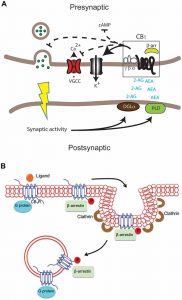
When the endocannabinoid system is mentioned, most people generally infer that it has something to do with cannabis, more commonly known as marijuana. What most don’t realize is that the endocannabinoid system is a natural occurring system within the body and has cannabinoid receptors to bind with endogenous ligands (endocannabinoids (eCB)). This system plays a prominent role in synaptic plasticity and homeostatic processes and has garnered quite a bit of research in the therapeutics department. CBD and THC, which can both be extracted from cannabis, are chemically similar to the body’s natural endocannabinoids. Using forms of CBD, THC, and arachidonic acid-derived endocannabinoids, Anandamide (AEA) and 2-Arachidonylglycerol (2-AG) have shown to have neuroprotective effects and pain reduction. So how exactly does the endocannabinoid system do this?
What is the Endocannabinoid System?

As previously stated, AEA and 2-AG are two of the major endocannabinoids expressed within the body. These, along with CBD and THC, bind to the cannabinoid 1 receptor (CB1) receptor. The CB1 receptor is a G protein-coupled receptor located on presynaptic neurons and mediates the CNS effects of the endocannabinoids. AEA and 2-AG are produced by the enzymes diacylglycerol lipase (DAGL) and phospholipase D (PLD) and then activate the CB1 receptor, which regulates adenylate cyclase activity and inhibits cAMP, voltage-gated calcium channels, potassium channels, and neurotransmitter release. There is also the CB2 receptor, which is more concerned with the immune system as it is largely associated with inflammation and localized to microglia. AEA and 2-AG are agonists for the cannabinoid receptors and are triggered by an influx of calcium at postsynaptic sites after synaptic activity. The endocannabinoid system works to regulate a variety of events including pain perception, neuroprotection, learning, memory, and mood.
The Endocannabinoid System’s Role in Therapeutics
The use of endocannabinoids in therapeutics has increased greatly in the past few years with CBD pop-up stores and the legalization of marijuana in a handful of states. To read more on CBD for pain relief, read here: https://www.healthline.com/health/cbd-oil-for-pain#arthritis-pain-relief. The endocannabinoid system though has garnered quite a bit of attention in research by being linked to a variety of CNS diseases like Multiple Sclerosis, Alzheimer’s Disease, Huntington’s Disease, and Traumatic Brain Injuries (TBIs). In TBIs specifically, it’s been found that the endocannabinoid 2-AG and endothelin (ET-1) induced vasoconstriction, which constricts blood vessels and lessens blood flow) both form after a TBI. The balance of the two is what determines how bad in jury may be.
2-AG activates the CB1, CB2, and TRPV1 receptors to counteract the ET-1 response and dilates the blood vessels, decreasing the injury severity. This means that the endocannabinoid system is exerting a neuroprotective effect and has also been shown to lower the expression of proinflammatory cytokines in the early stages of a TBI, lowering the severity of the injury in the long haul. You can read more on the effects of the endocannabinoid system and TBI here: https://link.springer.com/article/10.1007/s12035-007-8008-6
Increasing endocannabinoids by injecting synthetic 2-AG or AEA to relieve pain and decrease disease/injury severity still requires more research but is looking to be a promising avenue in therapeutics. Currently, use of CBD and THC derivatives in different treatment forms, whether it be gummies, pills, or smoking, all seem to be beneficial ways to relieve pain, especially chronic forms. Hopefully research will continue on the use of endocannabinoid system’s role in neuroprotection and pain perception to increase the therapy for these disorders and pain management options.